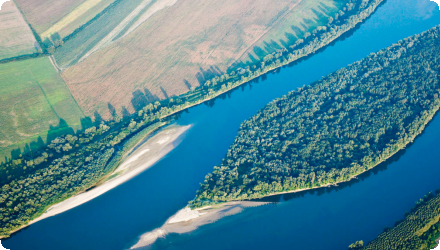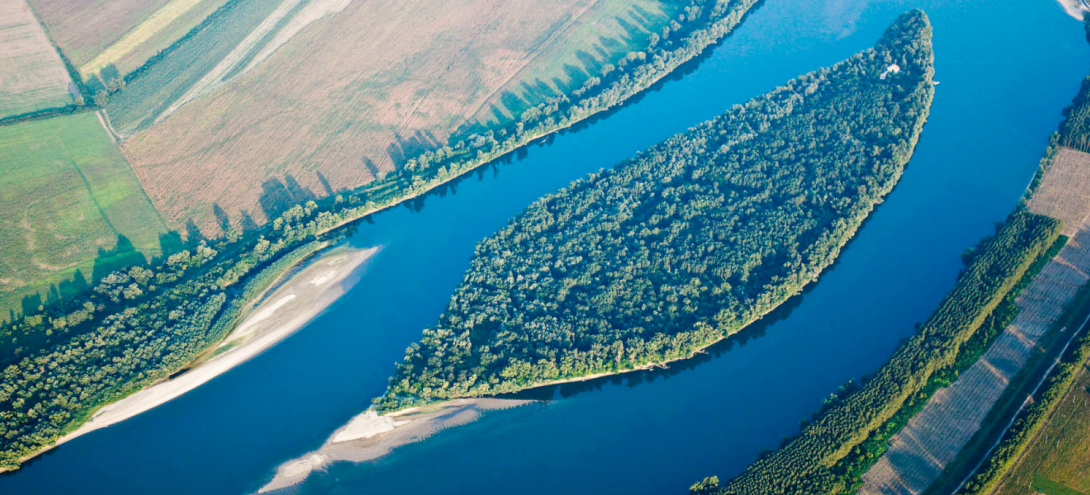Last update
2025
Summary
LIFE-Nature “Green Borders” (LIFE07 NAT/RO/000681, 2009–2013), coordinated by WWF with Romanian and Bulgarian partners, aimed to secure Pygmy Cormorant (Phalacrocorax pygmaeus) and Ferruginous Duck (Aythya nyroca) by restoring nesting/feeding habitats and promoting best fisheries management. It created a cross-border framework for 11 Natura 2000 sites along the Lower Danube.
Key works included improving the hydrological regime of Kaikusha marsh in Persina Nature Park (BG), completed in 2012, and the ecological reconstruction of the Gerai(ului) backwater at the Olt–Danube confluence (RO) in 2011.
The project’s studies supported the 2013 designation of three Transboundary Ramsar complexes (Iezerul Călărași–Srebarna, Suhaia–Belene Islands Complex, and Bistret–Ibisha), strengthening coordinated wetland management across the border.
Follow-up restoration in the Lower Danube Green Corridor continued under the Living Danube Partnership: water control was modernised at Persina/Kalimok and a further project prepared for Kaikusha; in Romania, >400 ha at Gârla Mare–Vrata were reconnected to the Danube in 2022. Note: in Sept 2021, a major fire burned most reedbeds at Kaikusha, temporarily degrading habitat.
Key works included improving the hydrological regime of Kaikusha marsh in Persina Nature Park (BG), completed in 2012, and the ecological reconstruction of the Gerai(ului) backwater at the Olt–Danube confluence (RO) in 2011.
The project’s studies supported the 2013 designation of three Transboundary Ramsar complexes (Iezerul Călărași–Srebarna, Suhaia–Belene Islands Complex, and Bistret–Ibisha), strengthening coordinated wetland management across the border.
Follow-up restoration in the Lower Danube Green Corridor continued under the Living Danube Partnership: water control was modernised at Persina/Kalimok and a further project prepared for Kaikusha; in Romania, >400 ha at Gârla Mare–Vrata were reconnected to the Danube in 2022. Note: in Sept 2021, a major fire burned most reedbeds at Kaikusha, temporarily degrading habitat.
Position
Latitude
43.5996
Longitude
25.185
Project
NWRM
National Id
Bulgaria_13
Installation date
2012
Implementation Status
Contact
REC
RBD code
BG1000
Transboundary
1
Photo gallery
Location of the project
Kaikusha Marsh (Persina Nature Park): ~5 km SE of Belene and ~2 km NW of Oresh, in the lands of Oresh (Svishtov Municipality). Balta Geraiului (Olt–Danube confluence): wetland between Gârcov (west) and Islaz (east) at the Olt–Danube confluence; the Ramsar sheet notes the DN6 to the north and DJ642 on the west as boundaries of the wider site.
Project's objectives
Biodiversity: “ensure living conditions” for Phalacrocorax pygmaeus and Aythya nyroca by reconstructing nesting/feeding areas and implementing best practices in fisheries management (project summary).
Hydrology – Kaikusha (BG): create a permanent water body with ≥ 0.6 m depth using two feeder canals (design flows 0.3 m³/s and 0.45 m³/s) and sluice structures.
Hydrology – Balta Geraiului (RO): block three drainage canals with small dikes; supply water via a ~900 m feeder canal tapping local brooks (~60–80 L/s) to maintain nesting-season water for target birds; ~600–900 ha reported as benefitting from improved conditions by project end.
Hydrology – Kaikusha (BG): create a permanent water body with ≥ 0.6 m depth using two feeder canals (design flows 0.3 m³/s and 0.45 m³/s) and sluice structures.
Hydrology – Balta Geraiului (RO): block three drainage canals with small dikes; supply water via a ~900 m feeder canal tapping local brooks (~60–80 L/s) to maintain nesting-season water for target birds; ~600–900 ha reported as benefitting from improved conditions by project end.
Involved Partners
| Authority type | Authority name | Role | Comments |
|---|---|---|---|
Climate zone
warm temperate dry
Temperature
11,7
Precipitation
600
Annual rainfall range
300 - 600 mm
Runoff coefficient
0,2
Runoff range
600 - 750 mm
Evapotranspiration
0,2
Elevation range
19 m
Slope range
2.0
Groundwater level
Phreatic waters in the Olt floodplain are interconnected with the river at 2.2–6.1 m depth; terrace deposits store groundwater at 15–20 m.
Vegetation class
Reedbeds / marsh macrophytes (Phragmites-dominated) around permanent/seasonal pools, plus floodplain softwood stands (willow–poplar) in the wider floodplain.
Water bodies: Ecological Status
Moderate
Water bodies: Chemical Status
Failing to achieve good
Project scale
Meso
Project scale specification
Hydromorphological interventions at Kaikusha (~155–160 ha) and Balta Geraiului (~600–900 ha benefiting from improved hydrological conditions); transboundary coordination exists.
Performance timescale
1 - 4 years
Area subject to Land use change or Management/Practice change (ha)
150
Total cost
€1,300,000
Costs total information
Total project value
Financing authorities
Type of funding
EU-funds: LIFE+
Type of funding
National funds
Compensations
0
Policy context
Part of the Danube River Basin Management Plan, Bulgaria’s National Wetlands Conservation Plan and National Biodiversity Strategy; also aligned with the Lower Danube Green Corridor initiative.
Land ownership
unknown
Community involvment
Yes
Design consultation activity
| Activity stage | Name | Key issues | Comments |
|---|
Policy target
| Target purpose |
|---|
|
Improved Biodiversity
|
Policy pressure
| Pressure directive | Relevant pressure |
|---|
Pressures remarks
Targeted problem: post-war embankments/drainage disconnected floodplains and degraded habitats; the measure aims to restore hydrological connectivity, generate suitable nesting/feeding conditions for Pygmy Cormorant and Ferruginous Duck, and improve broader wetland function. Relevant WFD pressure: hydromorphological alteration of the floodplain system (embankments, disconnected side arms/drainage).
Policy impact
| Impact directive | Relevant impact |
|---|
Requirement directive
| Requirement directive | Specification |
|---|
Contractual arrangements
0
| Arrangement type | Responsibility | Role | Name | Comments |
|---|
Part of wider plan
1
Wider plan type
| Wider plan type | Wider plan focus | Name | Comments |
|---|---|---|---|
|
Danube River Basin Management Plan
|
|||
|
National Wetlands Conservation Plan - BG
|
|||
|
National Biodiversity Strategy
|
Persina Nature Park runs a monitoring programme (water, birds, fish, mammals, reptiles, vegetation), while on the Romanian side the Romanian Ornithological Society monitored target bird species during the LIFE project; continued routine parameters after 2012 are not detailed in accessible sources. Persina’s official pages state monitoring of water, birds, fish, mammals, reptiles, and vegetation, used to guide water-quality control and wetland water-regime management; the Kaikusha technical brief also specifies hydraulic targets (e.g., maintaining a ≥ 0.6 m water layer using two feeder canals sized 0.3 m³/s and 0.45 m³/s through gated structures).
Maintenance
Bulgarian side: Persina Nature Park Directorate operates sluices/feeder channels to maintain target water levels at Kaikusha; for Balta Geraiului, sources describe built dikes and a feeder canal but do not specify a formal post-project maintenance regime.
Catchment outlet
Monitoring of target bird species
Payments for Ecosystem Services (PES) / biomass economy (Kaikusha): A pilot PES scheme was developed; a local entrepreneur signed a cooperation agreement with Persina NP to maintain the marsh via seasonal reed cutting and use the biomass for energy products (pellets/briquettes). The report details product quality tests and a business plan. These actions tie habitat maintenance to local income/energy substitution, though job/earnings figures aren’t quantified.
Fisheries & livelihoods (Persina complex, follow-on): The later sluice/monitoring upgrade cited above projected substantial fisheries benefits (carp recruitment), indicating positive spillovers for local fishers when water-level management is improved at these marshes.
Ecotourism/education (Kaikusha): Construction of a birdwatching tower, boardwalk and platforms aimed to improve visitor experience while managing disturbance - an enabling condition for nature-based tourism/education, though visitor numbers or revenues aren’t reported.
Fisheries & livelihoods (Persina complex, follow-on): The later sluice/monitoring upgrade cited above projected substantial fisheries benefits (carp recruitment), indicating positive spillovers for local fishers when water-level management is improved at these marshes.
Ecotourism/education (Kaikusha): Construction of a birdwatching tower, boardwalk and platforms aimed to improve visitor experience while managing disturbance - an enabling condition for nature-based tourism/education, though visitor numbers or revenues aren’t reported.
Retained water
200000
Retained water unit
m3/month
Information on retained water
The project delivered design and preparatory works to improve the water regime and restore open-water surfaces at Kaikusha, alongside a management model focused on reed biomass cutting to reopen habitat (WWF “market payments” pilot). These actions were aimed at reversing long-term reed overgrowth that had functionally altered habitats.
Increased water storage
100000
Increased water storage unit
m3/month
Water quality overall improvements
Positive impact-WQ improvement
Information on Water quality overall improvements
Nutrient capture
Soil quality overall soil improvements
N/A info
1
Actions included marking/guarding Ferruginous Duck and Pygmy Cormorant breeding sites and installing low-impact visitor infrastructure (boardwalk/observation tower) to channel access and reduce disturbance at Kaikusha. While site-specific bird count gains aren’t quantified in these sources, these measures were expressly targeted at maintaining local breeding colonies.
On 14 Sept 2021, >95% of the marsh vegetation burned during a severe drought after the wetland had dried out that summer; park staff reported no large vertebrate casualties, but major damage to vegetation and small fauna. This event temporarily erased habitat structure gains until regrowth.
On 14 Sept 2021, >95% of the marsh vegetation burned during a severe drought after the wetland had dried out that summer; park staff reported no large vertebrate casualties, but major damage to vegetation and small fauna. This event temporarily erased habitat structure gains until regrowth.
Ecosystem impact climate regulation
No information available
Information on Ecosystem provisioning services
Fisheries and reed harvest
Key lessons
Successful wetland restoration requires significant preparatory studies, including technical feasibility studies, which may exceed the duration and budget of the actual restoration works.
Hydrology must be engineered and then actively managed: Kaikusha’s design hinged on feeder canals/sluices and adaptive reed management, supported by monitoring and operational decisions rather than “one-off” works.
Cross-border governance multiplies impacts: the project’s planning fed directly into the 2013 designation of three Transboundary Ramsar complexes, locking in coordinated management across the border.
Climate extremes can abruptly erase gains: after summer drying, a 14 Sept 2021 fire burned >95% of Kaikusha’s reedbeds - underscoring the need for drought/fire contingencies in wetland O&M.
Linking habitat maintenance to local livelihoods (e.g., reed-biomass PES) helps sustain outcomes but requires time to mature technically and commercially.
Hydrology must be engineered and then actively managed: Kaikusha’s design hinged on feeder canals/sluices and adaptive reed management, supported by monitoring and operational decisions rather than “one-off” works.
Cross-border governance multiplies impacts: the project’s planning fed directly into the 2013 designation of three Transboundary Ramsar complexes, locking in coordinated management across the border.
Climate extremes can abruptly erase gains: after summer drying, a 14 Sept 2021 fire burned >95% of Kaikusha’s reedbeds - underscoring the need for drought/fire contingencies in wetland O&M.
Linking habitat maintenance to local livelihoods (e.g., reed-biomass PES) helps sustain outcomes but requires time to mature technically and commercially.
Success factor(s)
| Success factor type | Success factor role | Comments | Order |
|---|---|---|---|
|
Financing possibilities
|
main factor
|
<p>LIFE Nature</p>
|
1
|
|
Successful coordination between authorities
|
main factor
|
Strong RO–BG partnership aligned with Ramsar/Natura 2000 frameworks. |
|
|
Conducted assessments (incl. economic)
|
secondary factor
|
Active hydrological operation and ecological monitoring by Persina NP and partners. |
|
|
Available support tools
|
main factor
|
PES/biomass approach to maintain open water and manage reeds. |
Driver
| Driver type | Driver role | Comments | Order |
|---|---|---|---|
|
Organisation committed to it
|
main driver
|
Restoration of Kaikusha is part of larger project initiated by WWF
|
1
|
Transferability
Highly transferable to floodplain wetlands, provided robust feasibility and cross-border coordination. Pay close attention to hydrological design and adaptive O&M, align landowner interests early, secure long-term finance (e.g., PES), and plan for drought/fire contingencies in a changing climate.
English

